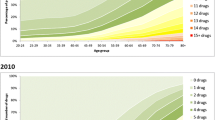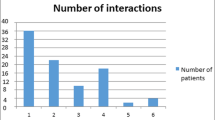Abstract
Background: Preventing the use of medications where there is the potential for serious drug-drug interactions or drug-disease interactions (contraindications) is essential to ensure patient safety. Previous studies have looked at the incidence of prescribing contraindicated drug combinations, but little is known about the underlying reasons for the co-prescribing events. The objectives of this study were to estimate the incidence of prescribing contraindicated drug combinations in general practice and to explore the clinical context, possible causes and potential systems failures leading to their occurrence.
Methods: A list of contraindicated drug combinations was compiled according to established references. A search of computerised patient medication records was performed, followed by detailed chart review and assessment. The patient records from four general practices in an area of England were searched for a period of 1 year (1 June 1999–31 May 2000) to identify contraindicated drug combinations. All patients registered with the four participating practices during the study period were included (estimated n = 37 940). Medical records of the cases identified by the computer search were reviewed in detail and relevant information was extracted. Each case was then independently assessed by a pharmacist and a physician who judged whether the co-prescribing was justified and whether it was associated with an adverse drug event. Proximal causes and potential systems failures were suggested for each co-prescribing event.
Main outcome measures and results: Fourteen patients with potential drug-drug interactions and 50 patients with potential drug-disease interactions were identified. Overall, these represent an incidence of 1.9 per 1000 patient-years (95% CI 1.5, 2.3) or 4.3 per 1000 patients being concurrently prescribed ≥2 drugs per year (95% CI 3.2, 5.4). 62 cases involving 63 co-prescribing events were reviewed. Two-thirds of these events involved medications that were initiated by hospital doctors. Awareness of the potential drug-drug or drug-disease interactions was documented in one-third of the events at the time of initial co-prescribing. Within the study period, the co-prescribing was judged to be not justified in 44 events (70%). Potential drug-drug interactions possibly resulted in two adverse drug events. The majority of contraindicated co-prescribing related to drug-disease interactions involved the use of propranolol or timolol eye drops for patients receiving bronchodilators and the use of amiodarone for patients receiving levothyroxine sodium.
Conclusion: The prescribing of contraindicated drug combinations was relatively rare in this study. Multiple possible causes and systems failures were identified and could be used to develop strategies for the prevention of prescribing errors involving contraindicated drug combinations in primary care.




Similar content being viewed by others
References
Jankel CA, Speedie SM. Detecting drug interactions: a review of the literature. DICP 1990; 24: 982–9
Linnarsson R. Drug interactions in primary health care. Scand J Prim Health Care 1993; 11: 181–6
Sipilä J, Klaukka T, Martikainen J, et al. Occurrence of potentially harmful drug combinations among Finnish primary care patients. Int Pharm J 1995; 9: 104–7
Stevens RG, Balon D. Detection of hazardous drug/drug interactions in a community pharmacy and subsequent intervention. Int J Pharm Pract 1997; 5: 142–8
Rosholm JU, Bjerrum L, Halls J, et al. Polypharmacy and the risk of drug-drug interactions among Danish elderly. Dan Med Bull 1998; 45: 210–3
Halkin H, Katzir I, Kurman I, et al. Preventing drug interactions by online prescription screening in community pharmacies and medical practices. Clin Pharmacol Ther 2001; 69: 260–5
Merlo J, Liedholm H, Lindblad U, et al. Prescriptions with potential drug interactions dispensed at Swedish pharmacies in January 1999: cross sectional study. BMJ 2001; 323: 427–8
Evans JMM, Hayes JL, Lipworth BJ, et al. Potentially hazardous co-prescribing of β-adrenoceptor antagonists and agonists in the community. Br J Gen Pract 1996; 46: 423–5
Valuck RJ, Perlman JI, Anderson C, et al. Co-prescribing of medications used to treat obstructive lung disease, congestive heart failure and depression among users of topical beta blockers: estimates from three US Veterans Affairs Medical Centers. Pharmacoepidemiol Drug Saf 2001; 10: 511–6
Hanlon JT, Schmader KE, Boult C, et al. Use of inappropriate prescription drugs by older people. J Am Geriatr Soc 2002; 50: 26–34
Hartshorn EA. Significance and interpretation of drug interaction information. Drug Intell Clin Pharm 1970; 4: 173
Stockley IH. Drug interactions. 5th ed. London: Pharmaceutical Press, 1999
Hansten PD, Horn JR. Hansten and Horn’s managing clinically important drug interactions. Vancouver (WA): Applied Therapeutics Inc, 1998
Naranjo CA, Busto U, Sellers EM, et al. A method for estimating the probability of adverse drug reactions. Clin Pharmacol Ther 1981; 30: 239–45
Leape LL, Bates DW, Cullen DJ, et al. Systems analysis of adverse drug events. JAMA 1995; 274: 35–43
Joint Formulary Committee. British National Formulary 39. London: British Medical Association and Royal Pharmaceutical Society of Great Britain, 2000
Newman CM, Price A, Davies DW, et al. Amiodarone and the thyroid: a practical guide to the management of thyroid dysfunction induced by amiodarone therapy. Heart 1998; 79: 121–7
Loh K-C. Amiodarone-induced thyroid disorders: a clinical review. Postgrad Med J 2000; 76: 133–40
Smalley W, Shatin D, Wysowski DK, et al. Contraindicated use of cisapride: impact of Food and Drug Administration regulatory action. JAMA 2000; 284: 3036–9
Jones JK, Fife D, Curkendall S, et al. Coprescribing and codispensing of cisapride and contraindicated drugs. JAMA 2001; 286: 1607–9
Weatherby LB, Walker AM, Fife D, et al. Contraindicated medications dispensed with cisapride: temporal trends in relation to the sending of ‘Dear Doctor’ letters. Pharmacoepidemiol Drug Saf 2001; 10: 211–8
Raschetti R, Maggini M, Da Cas R, et al. Time trends in the coprescribing of cisapride and contraindicated drugs in Umbria, Italy. JAMA 2001; 285: 1840–1
Jones FLJ, Ekberg NL. Exacerbation of obstructive airway disease by timolol [letter]. JAMA 1980; 244: 2730
Schoene RB, Martin TR, Charan NB, et al. Timolol-induced bronchospasm in asthmatic bronchitis. JAMA 1981; 245: 1460–1
Fraunfelder FT, Barker AF. Respiratory effects of timolol [letter]. N Engl J Med 1984; 311: 1441
Schoene RB, Abuan T, Ward RL, et al. Effects of topical betaxolol, timolol, and placebo on pulmonary function in asthmatic bronchitis. Am J Ophthalmol 1984; 97: 86–92
Diggory P, Heyworth P, Chau G, et al. Unsuspected bronchospasm in association with topical timolol -a common problem in elderly people: can we easily identify those affected and do cardioselective agents lead to improvement? Age Ageing 1994; 23: 17–21
Diggory P, Cassels-Brown A, Vail A, et al. Avoiding unsuspected respiratory side-effects of topical timolol with cardioselective or sympathomimetic agents. Lancet 1995; 345: 1604–6
Good CB. Topical beta-blockers in patients with co-existing conditions: is this a cause for concern? [editorial]. Pharmacoepidemiol Drug Saf 2001; 10: 509–10
Mageean RJ. Study of ‘discharge communications’ from hospital. BMJ 1986; 293: 1283–4
Penney TM. Delayed communication between hospitals and general practitioners: where does the problem lie? BMJ 1988; 297: 28–9
Williams EI, Fitton F. General practitioner response to elderly patients discharged from hospital. BMJ 1990; 300: 159–61
Coleman A, Ricketts L, Teal S, et al. An audit of hospital discharge and outpatient information from a primary care perspective. J Soc Adm Pharm 2001; 18: 226–31
Zermansky AG. Who controls repeats? Br J Gen Pract 1996; 46: 643–7
Bradley CP, Fraser A. Repeat prescribing. Br J Gen Pract 1997; 47: 255–6
Magnus D, Rodgers S, Avery AJ. GPs’ views on computerised drug interaction alerts: questionnaire survey. J Clin Pharm Ther 2002; 27: 377–82
Hazlet TK, Lee TA, Hansten PD, et al. Performance of community pharmacy drug interaction software. J Am Pharm Assoc 2001; 41: 200–4
Pringle M, Ward P, Chilvers C. Assessment of the completeness and accuracy of computer medical records in four practices committed to recording data on computer. Br J Gen Pract 1995; 45: 537–41
Acknowledgements
This study was funded by National Health Services R & D Support Funding for Primary Care, United Kingdom. We are grateful to the general practitioners and staff in the participating practices for their co-operation. At the time of manuscript revision, Yen-Fu Chen is affiliated with the Department of Public Health and Epidemiology, University of Birmingham and Michael Dewey with the Institute of Psychiatry, King’s College London, UK. The authors have no conflicts of interest that are directly relevant to the content of this study.
Author information
Authors and Affiliations
Corresponding author
Additional information
Department of Public Health and Epidemiology, University of Birmingham, Edgbaston, Birmingham, B15 2TT, UK.
Rights and permissions
About this article
Cite this article
Chen, YF., Avery, A.J., Neil, K.E. et al. Incidence and Possible Causes of Prescribing Potentially Hazardous/Contraindicated Drug Combinations in General Practice. Drug-Safety 28, 67–80 (2005). https://doi.org/10.2165/00002018-200528010-00005
Published:
Issue Date:
DOI: https://doi.org/10.2165/00002018-200528010-00005




